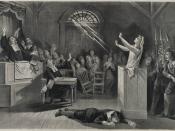In late 1692, a mass hysteria fell over the Puritan inhibited town of town of Salem Village, Massachusetts. Strange and often unexplainable phenomenon was experienced by the townspeople. The disturbing events that took place ware attributed to malevolence of witchcraft. In less than six months, 19 men and women were hanged, 17 innocents died in filthy prisons, an 80-year old man was crushed to death, and two dogs were stoned to death for collaborating with the Devil
The events of 1692 took place during a difficult and confusing period for Salem Village. As part of the Massachusetts Bay Colony, Salem was under British rule. When the hysteria began, the colony was waiting for a new governor and had no charter to enforce laws. By the time the new governor, William Phips, arrived in Massachusetts, the jails were already filled with alleged witches. To make matters worse, New England towns were under attack by Native Americans and French Canadians.
Salem Village faced daily challenges closer to home as well. Most families had to support themselves, making their own clothes, planting vegetables, raising meat. Farming was often a painstaking task in the harsh climate and rough, rocky terrain--and a drought or flood could ruin a year's harvest. An epidemic of smallpox could kill a family. In a world where people saw the Devil lurking behind every misfortune, it is little wonder they believed evil spirits were at work. But there may have been stronger factors behind the witch hunts--the Puritan lifestyle, a strong belief in the Devil and witchcraft, the divisions within Salem Village, and the expectations of children.
Church was the cornerstone of 17th century life in New England. Most people in Massachusetts were Puritans--colonists who had left England seeking religious tolerance. But the strict Puritan code was far from...


